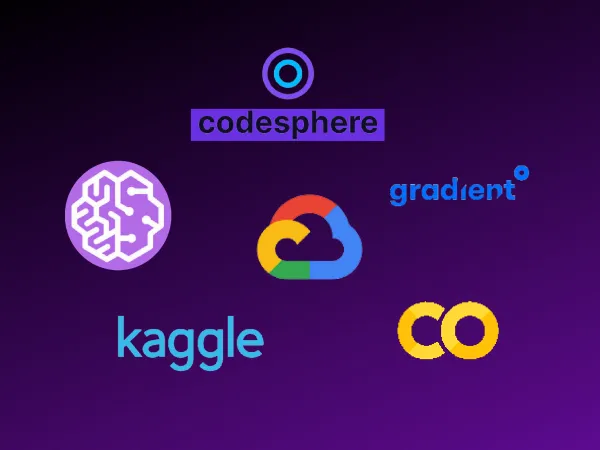5 Best Free Cloud GPU Providers For Hobbyists
The modern-day AI models require GPUs with high computing power that are crazy expensive. So, we compiled a list of Free Cloud GPU providers.

The advances in AI are great but the computing requirements are higher than ever and GPUs are multiple times more expensive than CPUs. Therefore, developers looking to get hands-on experience with these new technologies need to be resourceful in looking for GPU-providing companies that give away computing resources for free.
There are many options out there offering different kinds of freebies and conditions so in this article we set out to compare the most commonly known offerings. We considered several factors such as the availability of resources, computational power, quality of GPUs offered, idle time, persistent memory, as well as the limitations of use. Let’s see what each GPU provider currently offers.
Suggested Reading: Navigating the LLM Deployment Dilemma
Google Colab
Google Colaboratory or Google Colab is a notebook-based instance given by Google. It allows users to write and execute Python code in a web-based interactive environment. Google Colab is mainly designed for data science and machine learning tasks. You can access it by just signing in to your Google account. You don’t need to sign up with the entire Google Cloud.
Google Colab provides you Nvidia K80s or a Tesla T4 GPU if available with up to 16 GB of memory.
Pros
- You get 12 hours of free GPU access
- It is easy to use and set up.
- It does not require an extra cloud account setup.
- You can create and use public and private notebooks
- It can be integrated with Google Drive where you can save notebooks and access them anytime from Google Colab.
- As the name suggests, you can collaborate with other users in real-time.
Cons
- It can only work with notebooks.
- The GPU you get is shared.
- 30 minutes of being idle will stop your runtime.
- Practically not useful for bigger models because you can run into memory issues because of the shared nature of the GPU.
- You need to reauthenticate and remount Google Drive every time you use it.
Kaggle
Kaggle is a popular platform for data science and machine learning enthusiasts. It has 50k versatile and publicly available data sets you can use for practice or research. On this platform, you get access to interactive courses and tutorials on several data science and machine learning topics.
Kaggel provides a notebook service just like Google Colab and is a step up from Google Colab. You get at least 30 hours/week of GPU usage. You can choose the GPU option you prefer. The two options are the NVIDIA Tesla P100 with 16 GB GPU memory and the Dual Tesla T4 that comes with 15 GB GPU memory. However, there are other limitations like nine hours of consecutive runtime.
Pros
- You get a good 30 Hours/Week of GPU.
- The 16 GB of GPU memory is not shared.
- The notebooks can run in the background and can be private or public.
- Kaggel gives default access to Kaggle datasets.
- Notebooks shared with people can be commented on which makes it easy to collaborate..
Cons
- The idle time of 20 minutes will stop your runtime.
- You can only work with Notebooks.
- The GPU options provided are slower than Google Colab.
- There is a limit of 9 hours on consecutive use.
Codesphere
Codesphere is an end-to-end DevOps platform that combines IDE and infrastructure. You can deploy any AI model on codesphere within seconds. When you sign up you get a free shared GPU to use along with 20 GB of storage. In addition to that you get some ready-to-use templates. So, you can just sign up and start using one of the pre-configured models. The server goes to sleep after 60 minutes of idle time but boots up in seconds on restart.
If you use the “of when unused” feature you can get each extra GPU for just $10 a month. The coolest thing about Codesphere GPU is that it is not just limited to notebooks and you can do practically anything you want. In addition, you can also get paid state-of-the-art GPUs like T4 and A100 on order.
Pros
- You are not restricted to work only with notebooks.
- There are no consecutive hours restrictions.
- You do not have to go through a complex setup procedure.
- You get awarded an unlimited number of hours each month.
- Background execution of models is possible.
- The workspaces provide collaboration with others.
- You do not need a credit card to get started.
Cons
- You get a shared GPU.
- Some of the other providers offer a bit higher storage.
- Availability subject to demand (currently we have more demand than we can serve most of the times, if you want to check out affordable paid GPUs you might want to check out our french DC in partnership with arkane cloud at https://ide.arkanecloud.com/ide/signup)
Gradient by Paperspace
Gradient is an AI and ML development platform that offers MLOps services. It is meant to provide a number of tools and services that make it easy to develop and deploy ML models. When it comes to the free GPU, Paperspace seems like it is the best of the bunch but also the least practical of all. It gives you the highest RAM and the highest number of CPUs. On the other hand, it has the least amount of storage, and notebooks are not private.
Pros
- Gradient provides 30 GB RAM which is the highest amongst all.
- The idle time can be between 1-6 hours.
- It is extremely user-friendly.
- The format allows for collaboration between people.
Cons
- Gradient offers an almost negligible storage capacity of just 5 GB.
- It can only work with Notebooks.
- All the notebooks are public.
- Maximum execution time per session is 6 hours.
- In the free tier, you cannot access notebook terminals.
Sagemaker by Amazon
Sagemaker Studio Lab is considered a direct Google Colab competitor and Amazon owns it. Like Google Colab, it is also limited to Notebooks. However, you do not need to enter a credit card to get started or make an AWS account. To get started, you have to just provide your email, and wait for your request to get approved. Sagemaker provides a Tesla T4 GPU with persistent 15 GB storage. Even though the storage and GPU are powerful, it allows a very limited runtime.
Pros
- You get 15 GB of persistent storage.
- It offers a Powerful GPU with 16GB memory (not shared).
- With Sagemaker, background executions are possible.
- You do not have to provide credit card details.
Cons
- It allows only four hours of runtime.
- You can use it for 8 hours a day.
- You have to wait a few days for AWS to review and accept your access request.
Google Cloud GPU
When we talk about computing in any sense, it goes without saying that Google Cloud has something to do with it. Although with Google Cloud you don’t get a free GPU, you do get one-time 300$ credits when you sign up. The Google Cloud AI seems to solve all the abovementioned problems but comes with a hefty price once your credits run out. This actually defeats the purpose of using it for a considerable period of time for free.
Pros
- It is not limited to Notebooks and provides a complete system.
- High memory and high CPU can be demanded.
- The 300$ credit is granted on signup.
- You can easily integrate with all Google services.
Cons
- The free credit is usually used within days if not hours.
- A credit card is required to get started.
- It is not ideal because your project can be interrupted anytime your free credits run out.
Wrapup: Use a Combination of Free Cloud GPU Providers
All the Free Cloud GPU-providing platforms in the list, offer unique features. While choosing, it is advised to consider the requirements of your task, the suitable GPU, and the platform's limitations. It is also important to notice that the terms of use and availability of these free GPU providers might change with time, so it is good to visit their respective websites. We would also advise to combine multiple free offerings to get what you need.
We hope you found this article informative and helpful. Do let us know, if you think we missed any free GPU provider that should have made it to the list.
Suggested Reading: Self-hosted vs. API-based LLMs

